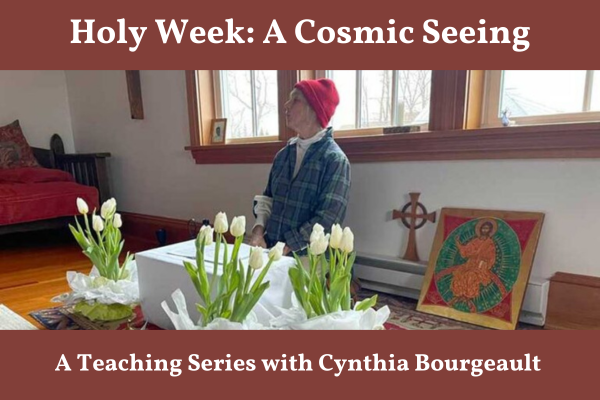An Introduction from Cynthia Bourgeault
These morning talks were offered as part of an intensive Holy Week retreat at my home in Rockland, Maine, attended by twenty-two of my experienced Wisdom students. The circumstances offered a unique, “bucket list” teaching opportunity for me: the chance to directly interweave the Christian experience of Holy Week — in all its mystical splendors and theological challenges — with powerful reference points found in the Gurdjieff Work.
In these talks I explore how Gurdjieffian insights on intentional suffering, conscious love, and “the cost of our arising” bring powerful new validation to the classic atonement theology that has been a stumbling block for so many, while reframing it away from its traditional shaming and punitive overtones. By these same insights it becomes possible to revisit and reclaim that bedrock early Christian proclamation that Christ’s death and resurrection was not only a historical but a cosmogonic event; it literally changed the foundation of the worlds.
From Gurdjieffian perspectives of the ray of creation and “reciprocal exchange,” we can see how this otherwise outrageous and even offensive claim (to our modern, liberal/progressive ears) may have more moxie in it than we allow ourselves to believe — and that this cosmic moxie is still there for us to draw on to renew our faith and renew our world. We drew on it liberally, collectively, during our retreat time together, and I believe you’ll find it still vibrating in these talks.
For those of you still deeply drawn to the Christian Mystery but put off by its heavy-handed ways of explaining itself, this brand new material may be right up your alley. In addition to Gurdjieffian reference points, you’ll also find several of my usual suspects: Jacob Boehme, Ladislaus Boros, Pierre Teilhard de Chardin, and Thomas Keating: the best of the best of the Christian mystical tradition. Plus, of course, Jesus himself, speaking his deepest truth in a context of conscious love and compassionate self-offering on behalf our this world of ours “that God so loved.”
To begin this self-guided, on-demand teaching, click on each course title at the bottom of this page.
We Appreciate Your Contribution


